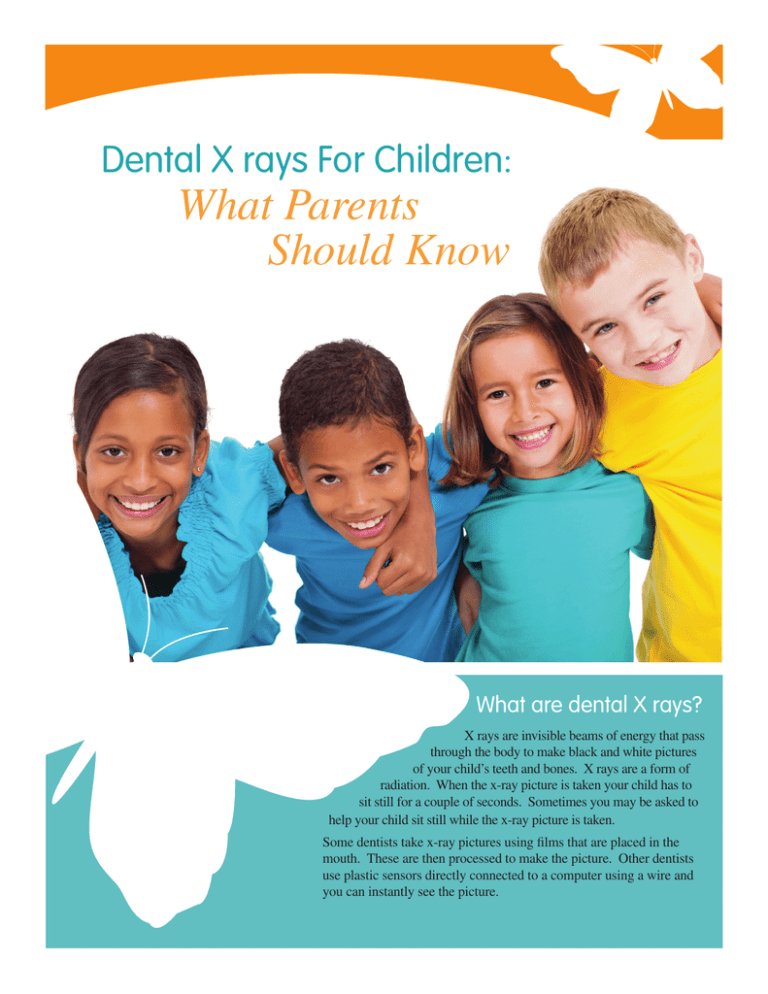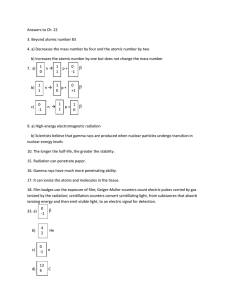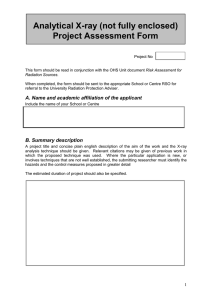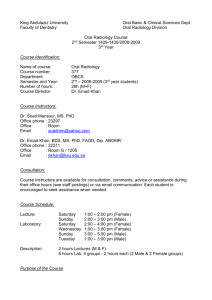Dental X rays For Children
advertisement

Dental X rays For Children: What Parents Should Know What are dental X rays? X rays are invisible beams of energy that pass through the body to make black and white pictures of your child’s teeth and bones. X rays are a form of radiation. When the x-ray picture is taken your child has to sit still for a couple of seconds. Sometimes you may be asked to help your child sit still while the x-ray picture is taken. Some dentists take x-ray pictures using films that are placed in the mouth. These are then processed to make the picture. Other dentists use plastic sensors directly connected to a computer using a wire and you can instantly see the picture. What are the different types of dental X rays? Bitewings – the x-ray film or plastic sensor has a little tab in the middle that the patient bites on with their back teeth. These x-ray pictures help look for cavities between the back teeth. Periapicals – these x-ray pictures are used to look at the roots of front or back teeth. Each periapical x-ray picture can only look at two or three teeth. Panoramic x ray – a machine that rotates around the outside of the head takes this picture. It can show all the jaw bones and all the teeth. Cone Beam CT – this is like a medical CT scan but it uses less x rays. However, the cone beam CT uses more x rays than bitewing, periapical or panoramic x rays. It helps make three-dimensional (3D) pictures. It is used infrequently compared to the other types of dental x rays. How much radiation is used in dental X rays? The dentist will use only enough radiation to see what he or she needs to care for your child. We all are exposed to small amounts of radiation daily from the sun, soil, rocks, buildings, air and water. This type of natural radiation is called background radiation. The radiation used in x rays has been compared to the amount of background radiation a person gets daily to help you understand how much radiation your child is getting during their x-ray exam. Radiation Source* Days of Background Radiation Background 1 day Airline Passenger (4 hour flight) 1 day 2 Dental Bitewing X rays 1 day 1 Dental Panoramic X ray 1 day 1 Dental Cone Beam CT 2- 20 days 1 Head CT 243 days How can we reduce the radiation to my child? The amount of radiation from one dental x –ray picture is very small. Still, it is important to keep the radiation amount as low as possible. Your dentist will balance the benefit of the x-ray picture and the potential small risks of using x rays. Different x –ray pictures are chosen based on the dental care needed. There are ways to make sure your child is exposed to the lowest amount of radiation possible during an x-ray picture. The Image Gently campaign suggests making sure that your dentist uses the following: • X-ray pictures based specifically on your child’s needs, not merely as a routine test • Up to date equipment and techniques • Thyroid collars to protect the thyroid gland from radiation (it is particularly sensitive to radiation) and protective shields as needed for other parts of the body • Child-size exposure times • Cone-beam CT only when necessary Who should I talk to if I still have concerns about dental x rays for my child? You should first talk to your child’s dentist and you can share the information in this brochure. Second, you can visit the Image Gently website at: www.imagegently.org. There is information on this website for everyone who plays a role in the child’s dental health including; parents, technologists, medical physicists, and dentists. There are also additional links to other helpful websites. What are the risks from radiation? The risk from a single dental x-ray picture is very small. However, some studies do show a slight increase in cancer risk, even at low levels of radiation exposure, particularly in children. To be safe, we should act as if low doses of radiation may cause harm. *Data taken from The Essential Physics of Medical Imaging, Bushberg et al, 3rd Edition, 2012 and radiologyinfo.org







